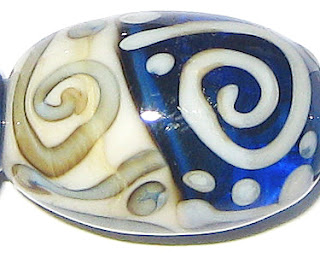1 - Plain, 2 - Plain (reduced), 3 - Over Clear, 4 - w/ Silver Leaf, 5 - w/ Silver Leaf (reduced and encased), 6 - w/ Reduced Silver Glass Frit, 7 - w/ TerraNova2 Frit, 8 - As a floral (over White), 9 - w/ Copper Green, 10 - w/ Opal Yellow, 11 - w/ Ivory, 12 - w/ White, 13 - w/ Raku
General Impressions
It is really hard to tell CiM Charcoal rods apart from Black if stuff gets mixed up. In fact, during its time in my working box, I have lost a rod of Charcoal and I think it has covertly combined itself with my bundle of Tuxedo, which will no doubt screw me right up down the road. Grrr. The four other rods I have are all subtly transparent letting just the tiniest amount of light through them, but in spite of my careful and repeated examination of all of my Tuxedo rods, I can't find that missing rod of Charcoal and it seems to be a goner.
Charcoal had some weird white spots on the rods that smoked in the flame, but this didn't result in anything weird being evident in the finished beads. It looks green when it's hot, especially in thin layers, which is really strange. Holly says that it looks green cooled down too, but I have to admit that I just don't see it. Maybe just a little on top of Opal Yellow?
Charcoal is much softer than I thought it was going to be. It's wonderful to encase with, and doesn't bubble while working. I like this colour. A LOT.
Alone, Charcoal is a pretty dark grey. It looks black, really... you can't see through it at all. Over Clear, it lightens up a little, but if you look at the lentil below you can only barely see the mandrel line through the centre of the bead, so it's still a very dark colour.
In a thin layer over White, Charcoal lightens up much more, and is a pleasant dark grey colour. Ignore the odd orange bits in the bead above... those seem to be Charcoal reacting to my camera flash because they aren't present in the bead when it's right in front of you.Reactions
Lots to see here! This is a really fun, reactive colour with some new things to bring to the table that I haven't encountered yet in my colour tour.
In the bead on the left, I melted silver leaf onto the surface of the Charcoal. That simple step has resulted in a variegated blue finish that is pretty cool... I have had silver turn blue and green on top of other colours (CiM Mink comes to mind) but never this colour of blue before.
In the bead on the right, I reduced and encased some silver leaf on top of Charcoal, under Effetre 006 Clear. The result is that shiny silver blanket I so often get, but accompanied by vibrant blue staining on either side of the silver. Awesome.
Silver Glass loves Charcoal, and Charcoal totally seems to love it back. These pictures are sort of dark, but even with my crummy photography, you can still easily see how awesome both the reduced silver glass frit (on the left) and the TerraNova2 frit (on the right) look on top of Charcoal. This glass has shot up to the top of my wish list in terms of ordering more.
I got weird colour out of Raku on top of Charcoal. Instead of the washed out brownish blue and brownish green I usually get, I got reds, pinks, blues and yellows. Neat.
On top of Charcoal, Copper Green separates so that it is lighter on the outside than it is in the middle of the dots and stringer lines I applied. Charcoal also seems to help Copper Green stay beautiful and unsheened with that silvery grey stuff.
When I put Charcoal on top of the Copper Green, the Copper Green got sort of striated and odd-looking and a lighter line formed around the Charcoal lines and dots.
In the middle of the bead, a lot of the darker colour in the Copper Green seems to have fled away from where the Copper Green and Charcoal meet.
Opal Yellow seems to separate a little when used on top of Charcoal, and on top of Opal Yellow the Charcoal takes on a greenish hue. It also seemed to spread a little.
Charcoal spreads a little on top of Ivory, too. It's a little strange because I'm used to transparents being denser and not really all that prone to spreading on top of the softer opaque colours. Charcoal also looks a little more blue on top of Ivory, especially when you compare it to how it looks on top of Opal Yellow above.
Ivory lines on top of Charcoal look crisp and beautiful and get just the faintest amount of separation that makes the edges look really well established in my stringer lines and dot work.
White and Charcoal don't really have much of a reaction and I got lazy here in the bead on the right.
I made a pretty cool clear-encased bead with Charcoal and reduced silver glass frit, and I meant to take a picture of it, but someone bought it from me while I was having lunch at the Fraser Valley Bead Show in Langley last weekend. I've remade it, so here it is with a friend.







































